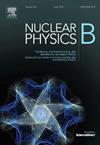Holographic Einstein ring of AdS-Reissner–Nordström black holes with Euler–Heisenberg nonlinear electrodynamics
IF 2.8
3区 物理与天体物理
Q2 PHYSICS, PARTICLES & FIELDS
引用次数: 0
Abstract
This study, situated within the framework of the AdS/CFT correspondence, employs wave optics methods to investigate the Einstein ring structure of quantum-corrected AdS–Reissner–Nordström black holes governed by Euler–Heisenberg nonlinear electrodynamics. A wave source placed on the AdS boundary yields a response function on the antipodal side, from which a virtual optical system with a convex lens reconstructs the holographic image of the Einstein ring. The analysis systematically explores the impact of physical parameters and observer position on the ring's morphology. As the observer's position varies, the image transitions from a complete ring to an arc and eventually to a single bright point. The Einstein ring radius is observed to decrease with increasing wave frequency ω, and chemical potential μ, while it increases with electric charge e and temperature T. Increasing η reduces the image sharpness. In contrast, the quantum correction parameter a has negligible effect on the ring radius or response amplitude, as its contribution falls off rapidly near the boundary and remains subleading in the wave dynamics. The parameter e enhances the electromagnetic lensing strength, leading to a broader ring. Geometric optics analysis confirms that the incident angle of the photon ring matches the Einstein ring angle, validating consistency across frameworks. Overall, the results highlight how nonlinear electromagnetic effects and bulk field configurations manifest in observable boundary features, providing a means to distinguish quantum-corrected black holes from classical solutions.
全息爱因斯坦环AdS-Reissner-Nordström黑洞与欧拉-海森堡非线性电动力学
本研究位于AdS/CFT对应的框架内,采用波动光学方法研究了由欧拉-海森堡非线性电动力学控制的量子校正AdS-Reissner-Nordström黑洞的爱因斯坦环结构。放置在AdS边界上的波源产生对映侧的响应函数,通过该响应函数,带有凸透镜的虚拟光学系统重建爱因斯坦环的全息图像。分析系统地探讨了物理参数和观察者位置对环形貌的影响。随着观测者位置的变化,图像从一个完整的环过渡到一个圆弧,并最终过渡到一个单一的亮点。爱因斯坦环半径随波频率ω和化学势μ的增大而减小,随电荷e和温度t的增大而增大。相比之下,量子修正参数a对环半径或响应幅度的影响可以忽略不计,因为它的贡献在边界附近迅速下降,并且在波动力学中仍然处于次领先地位。参数e提高了电磁透镜强度,导致环更宽。几何光学分析证实,光子环的入射角与爱因斯坦环角匹配,验证了框架之间的一致性。总的来说,结果突出了非线性电磁效应和体场配置如何在可观测的边界特征中表现出来,提供了一种将量子修正黑洞与经典解区分开来的方法。
本文章由计算机程序翻译,如有差异,请以英文原文为准。
求助全文
约1分钟内获得全文
求助全文
来源期刊

Nuclear Physics B
物理-物理:粒子与场物理
CiteScore
5.50
自引率
7.10%
发文量
302
审稿时长
1 months
期刊介绍:
Nuclear Physics B focuses on the domain of high energy physics, quantum field theory, statistical systems, and mathematical physics, and includes four main sections: high energy physics - phenomenology, high energy physics - theory, high energy physics - experiment, and quantum field theory, statistical systems, and mathematical physics. The emphasis is on original research papers (Frontiers Articles or Full Length Articles), but Review Articles are also welcome.
 求助内容:
求助内容: 应助结果提醒方式:
应助结果提醒方式:


